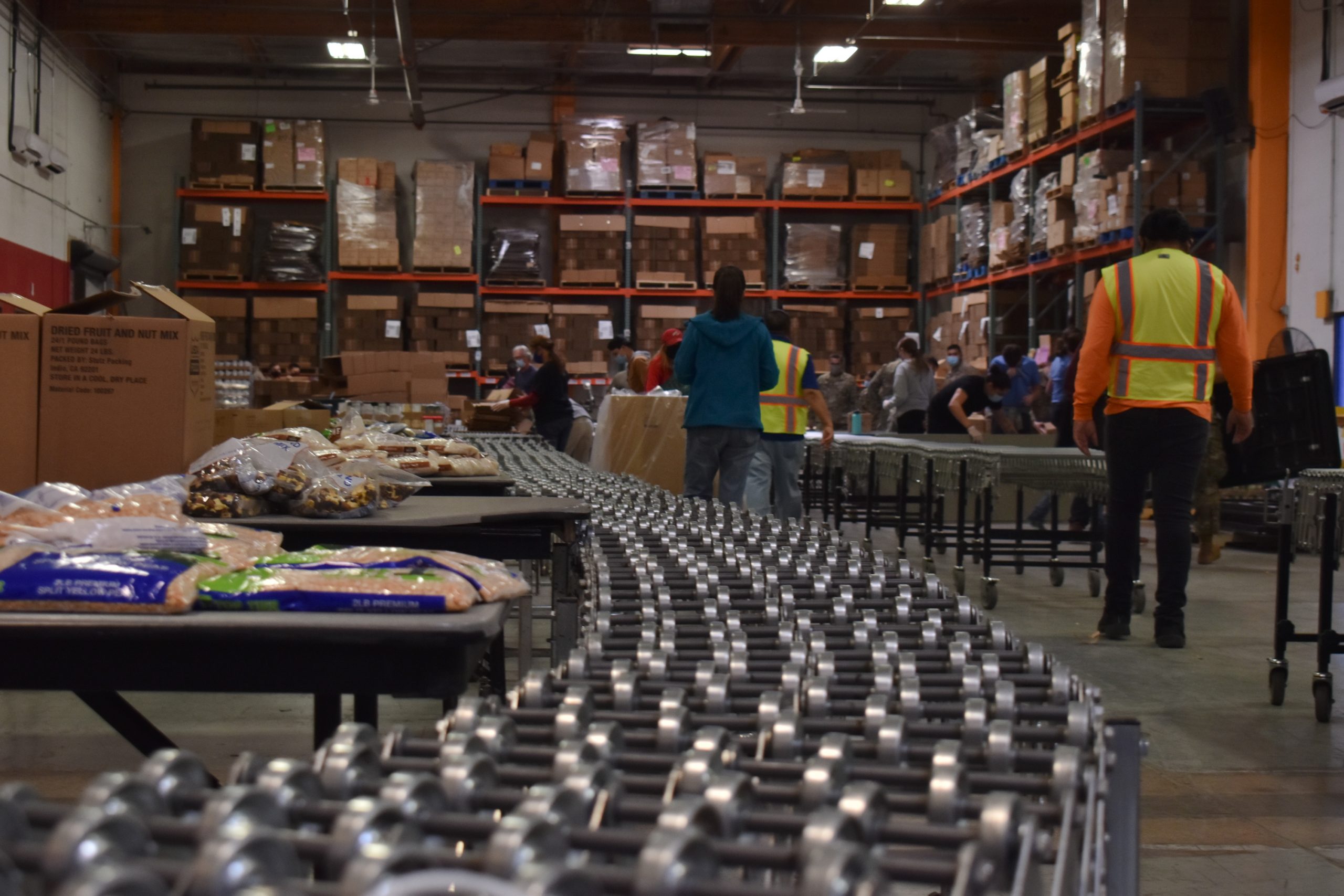Hunger in America is on the rise, putting more pressure on food banks already struggling to keep up with the unprecedented need during the COVID-19 pandemic. St. Mary’s Food Bank, which has been feeding families for more than five decades, has seen the need soar over the past several months, spokesman Jerry Brown said. A potent combination of lost jobs and health and safety issues – all springing from the contagion – have led to record distributions of 10 million pounds of food per month in late 2020.
“We want to try to make sure that people during this time are at least able to have access to healthy foods and to keep their families going, especially with so many of them still not working, or at least not working to full capacity,” Brown said.
Food banks in the U.S. distribute more than 86 million meals each year, according to feeding america.org. But food insecurity in the U.S. is exacerbated in the pandemic.
Feeding America estimated losses in the battle to fight food insecurity for Arizona’s children, with the percentage of Arizona children who were food insecure expected to jump from 19% in 2018 to nearly 29% in 2020.
Brown noted there are several food banks in Arizona, including three Feeding America food banks, adding, “There’s also a lot of other people out there that are doing this work as well.”
Brown, who said working to provide a vital need invigorates him, recently discussed how the food bank has expanded and adapted its services during a pandemic, how people who never needed St. Mary’s help now are calling on it for donations, as well as how the demand for volunteers has become acute.
The interview has been edited and condensed for clarity.
How would you describe the past year?
The impact in the community and the need for food has skyrocketed here in Arizona.
We’ve been around for 53 years, and we have never seen a year like 2020 when it comes to the amount of food that we distributed and the ways that we have had to come up with to distribute that food. We averaged 10 million pounds a month distributed.
What was that experience like?
I don’t really know how to explain or describe it. Literally everything we’ve had to do at the food bank underwent an entire transformation. We couldn’t do everything, anything the way that we had done it before, we had to add all kinds of safety protocols.
We had to get food to people in different areas. We went from distributing the food at the food bank to distributing them in the parking lots of sports stadiums. And (there was) expanding our mobile pantries just to try to get food out to folks who need it. The amount of people that came to the food bank tripled in just 30 days.
About March of last year, we were seeing about 600 people across the street a day at our main location. We have hundreds of them (from) across the Valley in this one particular location that jumped to 1,500 people in just a few weeks. We had to really pull together.
At the same time that we did, the volunteers that we rely on to help us distribute that food almost disappeared – from folks who are afraid to come and people who were part of companies or part of conventions that weren’t coming to Arizona anymore. We had to come up with an entirely new way to distribute that food. This is done through walkups, drive-thrus and food delivery.
When you come to the food bank for food, your windows are rolled up, you never leave your car, it’s an entire non-contact situation. You pop the trunk on your car, the food is loaded into the truck. It’s just like you’re driving down the street to anything else. You don’t have to put yourself at risk.

What’s a situation that broke your heart?
(One woman) had worked at the same company for 25 years – thought she was going to retire from there after working for another 20 years. And she was furloughed for a few months – told that they would bring her back when things improved. She went through all of her savings during that time that she was furloughed, thinking that she would get her job back and be able to rebuild.
She got the call to come back and a week before she was expected to go back to work, the company closed the stores for good. She did not have a job that she thought she would have for the next 20 years. As we were loading food into the back of a car, she had resumes in the back seat of her car, trying to find a new job. You just realize the incredible impact this has had on people who never thought that they would be in this situation.
People who had been people who donated to the food bank or spent time volunteering at the food bank were now on the other side of the line receiving the food.
Does St. Mary’s need more volunteers?
As you’re well aware, the state of Arizona has one of the highest incidences of COVID in the country, if not the world. Again, the number of people that would come to the food bank started to tick up again. We did have a respite, during the summer; June, July and August.
We’re definitely 25 to 30% more than we had seen the previous year, but not on the same scale that we had seen through the spring months and allowed us to kind of catch our breath, and get ready for the next surge. Sure enough, that surge came during the holiday season. The good news is we’ve been able to provide food for every family that is struggling.
The reason that we’ve been able to do that is because the people of Phoenix and the people of Arizona have been so generous when it comes to the food bank – understanding that this is something that they need to help with, understanding that there are people that they know, or people in their family, even, that need the food bank’s help right now. There’s a line of cars around the block at the food bank today.
Is the government still assisting St. Mary’s?
We still have the National Guard here, and they are distributing food for us. In fact, they were building emergency food boxes this morning, because the number of volunteers – it had picked up during the holidays – but it’s now dropped down again during January, so we didn’t have enough people to go through boxes. The guard was helping us out.
We’ve also received financial assistance, both from the federal government and from the state of Arizona, to help us. One of the things that we’ve instituted with that money is a delivery service for our seniors. Our folks who can’t leave the house are folks who are afraid to come to the food bank. They haven’t received their vaccinations yet, they want to make sure that they stay safe.
It was a $600,000 grant that was given by the state of Arizona, and we’ve been able to institute that. We’ve jumped the number of people that we deliver food to from about 1,100 a month to about 4,000 a month, with an eye towards increasing that total until everyone gets vaccinated. This is a very dangerous time, especially for our seniors, and we want to make sure that they’re able to receive the food they need without risking themselves.
If you have somebody who can take you to the food bank, somebody who can pick up food for you, we would much rather use that ability. But if you have no other choice,
we do have an option now where we can get the food to you.
What can people do to help the food bank – donate time, money and food?
Volunteers. Again, we’re serving 1,000 families a day. That means we need a box of food for 4,000 people a day. This is why volunteers are very important. We have two volunteer shifts a day. One starts at 9 a.m. and one starts at 1 p.m.; they last about 90 minutes, and you will box hundreds, if not thousands, of emergency food boxes.
During that time, we pump out a lot of rock and roll music. It’s a very safe environment. All of our volunteers have their temperature checked, wear their masks and gloves, they’re 6 feet apart.
It may not be the same raucous atmosphere that we normally have for an emergency food boxing event. But you can certainly still feel the happiness of folks wanting to help out, and we do it in a very safe manner.
If you have some citrus on your backyard trees, you can bring those. Grapefruits, those oranges, the things that you don’t want to have around your house, a lot of these trees are very abundant.
Cash donations are always important. Every dollar that we received with the food bank we can turn into seven meals. You can do that very safe and securely by going to firstfoodbank.org and making a donation.
What preparations do you have for this year compared to last year?
We have learned how to do things in a new way, in a more efficient way and at a much more larger scale. We expect to continue that until we’re in a place, hopefully, by the middle to late part of the summer, where things get more back to normal.
Story by Lilia Stene, Cronkite News




